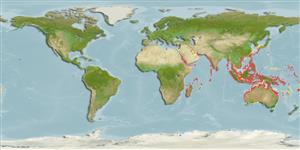Common names from other countries
Environment: milieu / climate zone / depth range / distribution range
экология
; пределы глубины 5 - 30 m (Ref. 348). Tropical
Indo-Pacific: from East Africa, to Micronesia; north to Japan and south to Indonesia.
Length at first maturity / Size / Вес / Возраст
Maturity: Lm ? range ? - ? cm Max length : 20.5 cm SHL самец/пол неопределен; (Ref. 348); common length : 10.0 cm SHL самец/пол неопределен; (Ref. 348)
The relatively small yield of its meat makes this oyster rather unattractive as an aquacultural species (Ref. 348). Mostly in shallow subtidal waters (Ref. 348). Known to be poisonous (Ref. 101155).
Life cycle and mating behavior
половая зрелость | размножение | нерест | икра | Fecundity | личинки
Members of the class Bivalvia are mostly gonochoric, some are protandric hermaphrodites. Life cycle: Embryos develop into free-swimming trocophore larvae, succeeded by the bivalve veliger, resembling a miniature clam.
Основная ссылка
ссылки | координатор | соавторы
Poutiers, J.M. 1998. (Ref. 348)
Статус Красного Списка МСОП (Ref. 130435)
Статус СИТЕС (Ref. 108899)
Not Evaluated
Not Evaluated
Использование человеком
| FishSource |
инструменты
дополнительная информация
Возраст/РазмерыростЗависимость между длиной и массой телаЗависимость между длинамиморфологияличинкичисленность
ресурсы в Интернет
Estimates based on models
Preferred temperature
(Ref.
115969): 24.7 - 29.3, mean 28.5 (based on 3496 cells).
Уязвимость
Low vulnerability (11 of 100).
Категория цены
Unknown.
